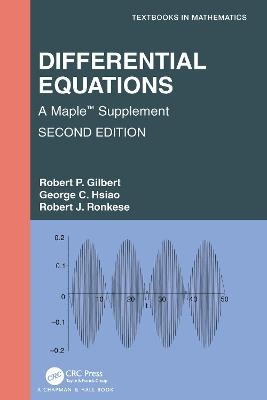
Differential Equations
Chapman & Hall/CRC (Verlag)
978-1-032-02179-9 (ISBN)
This book illustrates how MAPLE™ can be used to supplement a standard, elementary text in ordinary and partial differential equation. The authors are firm believers in the teaching of mathematics as an experimental science where the student does numerous calculations and then synthesizes these experiments into a general theory. The goal of the book is to teach the students enough about the computer algebra system MAPLE™ so that it can be used in an investigative way. This book was developed through ten years of instruction in the differential equations course.
Robert P. Gilbert holds a Ph.D. in mathematics from Carnegie Mellon University. He and Jerry Hile originated the method of generalized hyperanalytic function theory. Dr. Gilbert was professor at Indiana University, Bloomington and later became the Unidel Foundation Chair of Mathematics at the University of Delaware. He has published over 300 articles in professional journals and conference proceedings. He is the Founding Editor of two mathematics journals Complex Variables and Applicable Analysis. He is a three-time Awardee of the Humboldt-Preis, and. received a British Research Council award to do research at Oxford University. He is also the recipient of a Doctor Honoris Causa from the I. Vekua Institute of Applied Mathematics at Tbilisi State University. George C. Hsiao holds a doctorate degree in Mathematics from Carnegie Mellon University. Dr. Hsiao is the Carl J. Rees Professor of Mathematics Emeritus at the University of Delaware from which he retired after 43 years on the faculty of the Department of Mathematical Sciences. Dr. Hsiao was also the recipient of the Francis Alison Faculty Award, the University of Delaware’s most prestigious faculty honor, which was bestowed on him in recognition of his scholarship, professional achievement and dedication. His primary research interests are integral equations and partial differential equations with their applications in mathematical physics and continuum mechanics. He is the author or co-author of more than 200 publications in books and journals. Dr. Hsiao is world-renowned for his expertise in Boundary Element Method and has given invited lectures all over the world. Robert J. Ronkese holds a PhD in applied mathematics from the University of Delaware. He is a professor of mathematics at the US Merchant Marine Academy on Long Island. As an undergraduate, he was an exchange student at the Swiss Federal Institute of Technology (ETH) in Zurich. He has held visiting positions at the US Military Academy at West Point and at the University of Central Florida in Orlando
Preface. 1. Introduction to the Maple DEtools. 1.1. Analytical Solutions and their Plotting. 1.2. Direction Fields and Integral Curves. 1.3. Computer Lab. 1.4. Supplementary Maple Programs. 2. First-order Differential Equations. 2.1. Linear differential equations. 2.2. Project: Mixing problems. 2.3. Separable differential equations. 2.4. Exact Questions. 3. Numerical Methods for First Order Equations. 3.1. Picard’s Iteration Method and Semi-batch Reactor. 3.2. An Existence and Uniqueness Theorem. 3.3. Picard Iteration Method. 3.4. Computer Lab. 3.5. Numerical Procedures and Fermentation Kinetics. 3.6. The Euler Method. 3.7. Higher-Order Methods. 3.8. Maple Procedures. 3.9. Computer Lab. 3.10. Supplementary Maple Programs. 4. Differential Equations with Constant Coefficients. 4.1. Second order equations with constant coefficients. 4.2. Variation of Parameters. 4.3. The Method of Undetermined Coefficients. 4.4. Higher order, homogeneous equations. 4.5. Nonhomogeneous Linear Equations. 5. Applications of Second Order Linear Equations. 5.1. Simple Harmonic Motion. 5.2. General Solutions. 5.3. Method of Undetermined Coefficients. 5.4. Additional Useful Commands. 5.5. Computer Lab. 5.6. Supplementary Maple Programs. 5.7. Particular Solutions. 5.8. Computer Lab. 5.9. Supplementary Maple Programs. 6. Two-Point Boundary Value Problems, Catalytic Reactors and Boundary-Layer Phenomena. 6.1. Analytical Solutions. 6.2. Finite-Difference Methods. 6.3. Computer Lab. 6.4. Supplementary Maple Programs. 7. Eigenvalue Problems. 7.1. Sturm-Liouville Problems. 7.2 Numerical Approximations. 7.3. The Newton-Raphson Method. 7.4. Computer Lab. 7.5. Supplementary Mapple Programs. 8. Power Series Methods for Solving Differential Equations. 8.1. Nonlinear Differential Equations. 8.2. Regular-Singular Points. 8.3. Programs for finding solutions. 8.4. Projects. 9. Nonlinear Autonomous Systems. 9.1. The Taylor Series Method. 9.2. The Phase Plane. 9.3. Linear Systems. 9.4. Useful Maple Commands. 9.5. Computer Lab. 9.6. Supplementary Maple Programs. 10. Integral Transforms. 10.1 The Laplace Transform of Elementary Functions. 10.2. Solving Differential Equations with the Laplace Transform. 10.3. Fourier Transforms. 11. Partial Differential Equations. 11.1. Elementary Methods. 11.2. The First Order Partial Differential Equation. 11.3. The Heat Equation. 11.4. The Vibrating String. 11.5 The Laplace Equation. 12. Transmutations. 12.1. The method of ascent. 12.2. Orthogonal systems of functions. 12.3. Acoustic propagation. Bibliography. Index.
| Erscheinungsdatum | 30.06.2021 |
|---|---|
| Reihe/Serie | Textbooks in Mathematics |
| Zusatzinfo | 1 Tables, black and white; 69 Line drawings, black and white; 69 Illustrations, black and white |
| Sprache | englisch |
| Maße | 156 x 234 mm |
| Gewicht | 471 g |
| Themenwelt | Mathematik / Informatik ► Mathematik ► Analysis |
| ISBN-10 | 1-032-02179-9 / 1032021799 |
| ISBN-13 | 978-1-032-02179-9 / 9781032021799 |
| Zustand | Neuware |
| Informationen gemäß Produktsicherheitsverordnung (GPSR) | |
| Haben Sie eine Frage zum Produkt? |
aus dem Bereich


